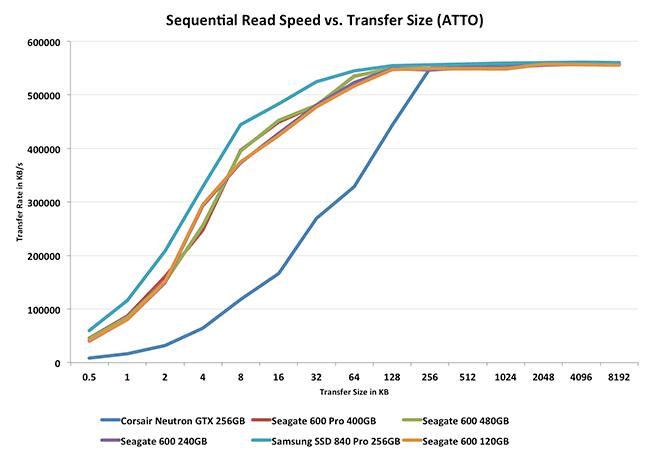The Seagate 600 & 600 Pro SSD Review
by Anand Lal Shimpi on May 7, 2013 8:00 AM ESTPerformance vs. Transfer Size
ATTO is a useful tool for quickly measuring the impact of transfer size on performance. You can get the complete data set in Bench. I pointed this out earlier but we see much better low queue depth sequential performance than on the Corsair drives, despite using the same controller (and presumably somewhat similar firmware). It's now very clear to me that Seagate had some degree of say in what happened at the firmware level on these drives.
Samsung maintains the best curve in these tests however. On the write side, the 120GB 600 is the only drive that tops out early.












59 Comments
View All Comments
numberoneoppa - Tuesday, May 7, 2013 - link
It's too bad about the idle power consumption, but if the prices are decent, I might pick up a higher capacity variant to replace my 80GB m25 G2 in my desktop.ssj3gohan - Tuesday, May 7, 2013 - link
I don't think Anandtech has implemented their improved (DIPM-enabled) power consumption tests yet, so the idle figures here are pretty much meaningless. When it comes to market, check the datasheet for actual idle power consumption.Kristian Vättö - Tuesday, May 7, 2013 - link
Seagate's datasheet shows average idle power of 1.1W: http://images.anandtech.com/doci/6935/Screen%20Sho...lightsout565 - Wednesday, May 8, 2013 - link
Does anyone know how power consumption compares to the 128GB Samsung 830? In Anand's review of the 830 he mentions, "Samsung sampled the 512GB version of the SSD 830 so it's unclear how much the sheer number of NAND die impacts power consumption here." During the test of the 513GB version, it showed 1.22W at idle.Kristian Vättö - Wednesday, May 8, 2013 - link
The 128GB SSD 830 idles at 0.38W (I think the firmware is also newer, the 512GB had pre-production FW as far as I know). As always, you can find all our SSDs (and other components) in the Bench, here's the 128GB SSD 830:http://www.anandtech.com/bench/Product/533
cactusdog - Tuesday, May 7, 2013 - link
I don't understand why Seagate and WD were so slow in the SSD market. They should have a complete range of SSDs by now. They could have just rebranded OEM drives (if they didn't want to spend money) and would have sold millions just from their name alone. Like Kingston and others did...... I don't get it.Sabresiberian - Tuesday, May 7, 2013 - link
I wonder if the main HD manufacturers here were doing a bit of "American auto industry" thinking. Like "We sold all the gas guzzlers we could make before, how are we supposed to know the general population is going to want cars that get better gas mileage?" Chrysler and GM had to be bailed out twice for that kind of thinking.So, were Seagate and Western Digital thinking "We're selling all the HDs we can make, why should we get into SSDs?" I don't know, but it's an explanation that seems to fit, to my way of thinking anyway.
Powerlurker - Tuesday, May 7, 2013 - link
I think it's more that Seagate and WD have extensive expertise in manufacturing HDDs that can't be replicated by competitors and lots of industrial infrastructure that only they (and Toshiba at this point) have. Meanwhile, on the SSD front, they would be competing with any idiot on the Pacific Rim with a reference design and a pick-and-place line. SSDs are rapidly becoming commodity products at the consumer level and long term profitability in the segment requires you to have your own special sauce (controller technology, firmware expertise, a NAND fab, or some other unique advantage) which WD and Seagate don't really have at this point.Kristian Vättö - Tuesday, May 7, 2013 - link
While WD and Seagate lack the SSD expertise, they have the distribution channels and resources. Hynix is a good example of a company that has all the expertise they need to develop a competitive SSD but their distribution channel is lacking. Seagate, on the other hand, operates globally and can reach billions of potential buyers in a short period of time. Even if you have a good product, it's fairly meaningless if it can't reach most of the market. Hynix actually makes SSDs but they are doing absolutely nothing to market them and I bet they don't have many distributors in the US or other Western countries (NewEgg sells their SSDs but I haven't seen them elsewhere).Seagate also has tons of capital to invest on the SSD market. Like in the case of this SSD, they didn't just go with stock SandForce but chose LAMD and invested on specializing the firmware. On top of that, I'm pretty sure Seagate has fairly big NAND deals with Toshiba and Samsung to ensure a steady supply of NAND, which requires capital. There have already been NAND shortages in the market and this year it will get even tougher - Seagate has an advantage because they can buy a ton of NAND whereas smaller players lack the capital for that (and the bigger client you are, the more important you are for the company so big clients are prioritized when there's a shortage).
What would be a killer combination in the future is Seagate and Hynix combining their powers.
secretAgent! - Tuesday, May 7, 2013 - link
WD is coming out soon with SSD PCIe cards soon.... i've helped test them.... shhhh....